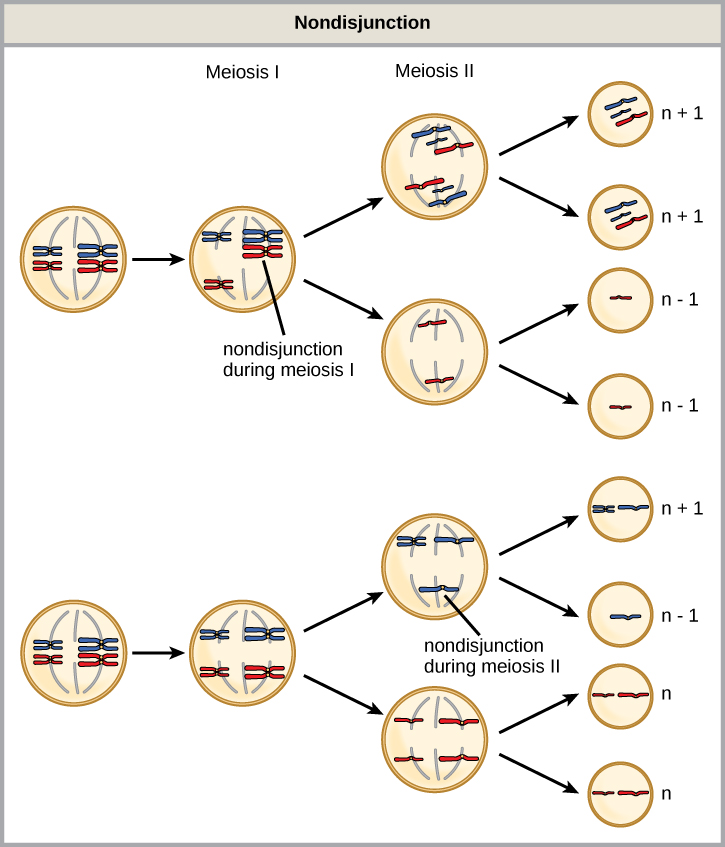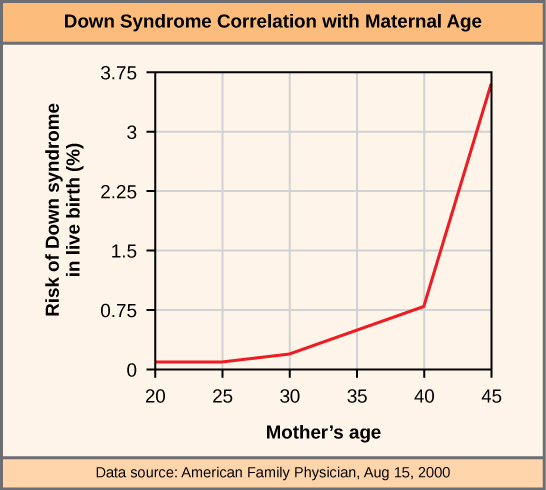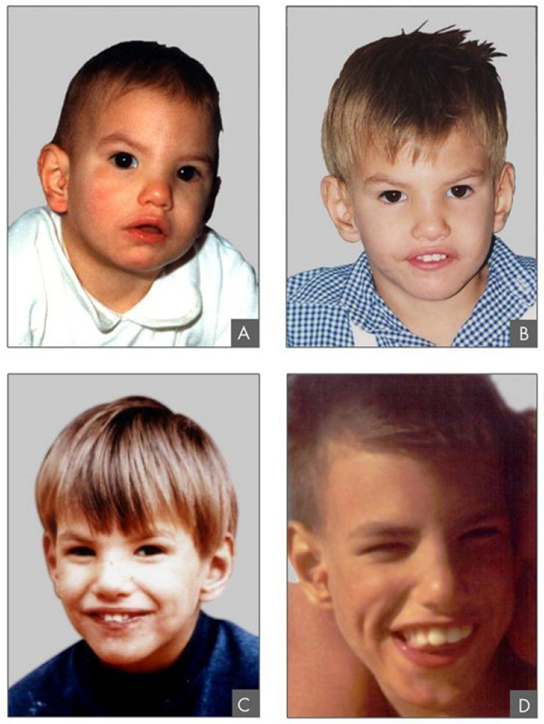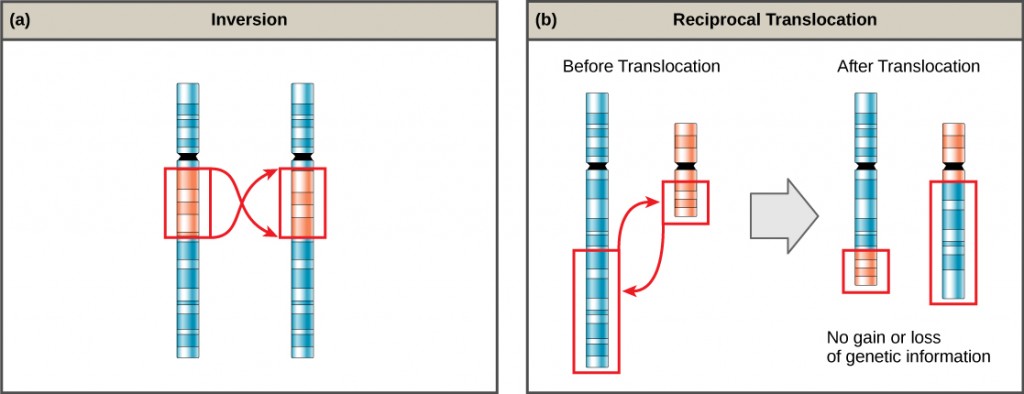What Is An Individualã¢â‚¬â„¢s Genetic Makeup Called?
Chapter 7: Introduction to the Cellular Basis of Inheritance
seven.3 Errors in Meiosis
Learning Objectives
Past the end of this section, you lot will be able to:
- Explain how nondisjunction leads to disorders in chromosome number
- Depict how errors in chromosome construction occur through inversions and translocations
Inherited disorders tin can arise when chromosomes behave abnormally during meiosis. Chromosome disorders can be divided into 2 categories: abnormalities in chromosome number and chromosome structural rearrangements. Because fifty-fifty small segments of chromosomes can bridge many genes, chromosomal disorders are characteristically dramatic and often fatal.
Disorders in Chromosome Number
The isolation and microscopic observation of chromosomes forms the ground of cytogenetics and is the primary method by which clinicians observe chromosomal abnormalities in humans. A karyotype is the number and appearance of chromosomes, including their length, banding blueprint, and centromere position. To obtain a view of an individual's karyotype, cytologists photograph the chromosomes and then cut and paste each chromosome into a chart, or karyogram (Figure 7.7).

Geneticists Use Karyograms to Identify Chromosomal Aberrations
The karyotype is a method by which traits characterized past chromosomal abnormalities can be identified from a single cell. To discover an individual'south karyotype, a person'due south cells (like white blood cells) are first collected from a claret sample or other tissue. In the laboratory, the isolated cells are stimulated to brainstorm actively dividing. A chemical is then applied to the cells to abort mitosis during metaphase. The cells are then fixed to a slide.
The geneticist and then stains chromosomes with 1 of several dyes to better visualize the distinct and reproducible banding patterns of each chromosome pair. Following staining, chromosomes are viewed using bright-field microscopy. An experienced cytogeneticist can identify each band. In addition to the banding patterns, chromosomes are further identified on the basis of size and centromere location. To obtain the classic depiction of the karyotype in which homologous pairs of chromosomes are aligned in numerical order from longest to shortest, the geneticist obtains a digital prototype, identifies each chromosome, and manually arranges the chromosomes into this pattern.
At its nearly basic, the karyogram may reveal genetic abnormalities in which an private has also many or too few chromosomes per cell. Examples of this are Down syndrome, which is identified by a third re-create of chromosome 21, and Turner syndrome, which is characterized past the presence of only ane Ten chromosome in women instead of two. Geneticists tin also identify big deletions or insertions of Dna. For example, Jacobsen syndrome, which involves distinctive facial features likewise as heart and bleeding defects, is identified by a deletion on chromosome 11. Finally, the karyotype tin pinpoint translocations, which occur when a segment of genetic material breaks from ane chromosome and reattaches to another chromosome or to a different office of the same chromosome. Translocations are implicated in certain cancers, including chronic myelogenous leukemia.
By observing a karyogram, geneticists can really visualize the chromosomal limerick of an individual to confirm or predict genetic abnormalities in offspring even before nativity.
Nondisjunctions, Duplications, and Deletions
Of all the chromosomal disorders, abnormalities in chromosome number are the well-nigh easily identifiable from a karyogram. Disorders of chromosome number include the duplication or loss of entire chromosomes, as well as changes in the number of complete sets of chromosomes. They are caused by nondisjunction, which occurs when pairs of homologous chromosomes or sis chromatids neglect to separate during meiosis. The risk of nondisjunction increases with the historic period of the parents.
Nondisjunction tin occur during either meiosis I or II, with different results (Figure 7.8). If homologous chromosomes neglect to split up during meiosis I, the consequence is two gametes that lack that chromosome and two gametes with two copies of the chromosome. If sister chromatids fail to separate during meiosis Ii, the result is one gamete that lacks that chromosome, two normal gametes with ane copy of the chromosome, and one gamete with two copies of the chromosome.

An individual with the appropriate number of chromosomes for their species is called euploid; in humans, euploidy corresponds to 22 pairs of autosomes and one pair of sex chromosomes. An individual with an error in chromosome number is described as aneuploid, a term that includes monosomy (loss of one chromosome) or trisomy (gain of an extraneous chromosome). Monosomic human zygotes missing any one copy of an autosome invariably fail to develop to birth because they have only one copy of essential genes. Most autosomal trisomies likewise fail to develop to birth; however, duplications of some of the smaller chromosomes (13, 15, 18, 21, or 22) can event in offspring that survive for several weeks to many years. Trisomic individuals suffer from a different type of genetic imbalance: an excess in gene dose. Jail cell functions are calibrated to the corporeality of gene product produced by two copies (doses) of each gene; adding a third copy (dose) disrupts this balance. The most common trisomy is that of chromosome 21, which leads to Downward syndrome. Individuals with this inherited disorder take feature physical features and developmental delays in growth and knowledge. The incidence of Down's syndrome is correlated with maternal age, such that older women are more likely to requite birth to children with Down syndrome (Effigy 7.nine).

Concept in Action
Visualize the add-on of a chromosome that leads to Down's syndrome in this video simulation.
Humans brandish dramatic deleterious effects with autosomal trisomies and monosomies. Therefore, information technology may seem counterintuitive that human females and males tin role usually, despite carrying unlike numbers of the X chromosome. In role, this occurs because of a process called X inactivation. Early in development, when female mammalian embryos consist of merely a few thousand cells, one X chromosome in each cell inactivates by condensing into a structure called a Barr body. The genes on the inactive X chromosome are not expressed. The particular X chromosome (maternally or paternally derived) that is inactivated in each cell is random, but once the inactivation occurs, all cells descended from that prison cell will take the same inactive X chromosome. By this procedure, females compensate for their double genetic dose of X chromosome.
In and then-chosen "tortoiseshell" cats, X inactivation is observed as coat-color variegation (Effigy 7.ten). Females heterozygous for an 10-linked glaze color gene will express i of 2 different glaze colors over different regions of their trunk, corresponding to whichever X chromosome is inactivated in the embryonic cell progenitor of that region. When you run across a tortoiseshell cat, you volition know that it has to be a female person.

In an private carrying an aberrant number of 10 chromosomes, cellular mechanisms will inactivate all but one X in each of her cells. As a result, X-chromosomal abnormalities are typically associated with mild mental and physical defects, equally well equally sterility. If the X chromosome is absent altogether, the individual will not develop.
Several errors in sex activity chromosome number have been characterized. Individuals with three X chromosomes, called triplo-X, appear female person but express developmental delays and reduced fertility. The XXY chromosome complement, corresponding to ane blazon of Klinefelter syndrome, corresponds to male individuals with small testes, enlarged breasts, and reduced torso hair. The actress Ten chromosome undergoes inactivation to compensate for the backlog genetic dosage. Turner syndrome, characterized as an X0 chromosome complement (i.e., but a unmarried sex chromosome), corresponds to a female person individual with short stature, webbed skin in the neck region, hearing and cardiac impairments, and sterility.
An individual with more than the correct number of chromosome sets (two for diploid species) is called polyploid. For instance, fertilization of an abnormal diploid egg with a normal haploid sperm would yield a triploid zygote. Polyploid animals are extremely rare, with only a few examples amidst the flatworms, crustaceans, amphibians, fish, and lizards. Triploid animals are sterile considering meiosis cannot proceed normally with an odd number of chromosome sets. In contrast, polyploidy is very common in the plant kingdom, and polyploid plants tend to be larger and more robust than euploids of their species.
Chromosome Structural Rearrangements
Cytologists have characterized numerous structural rearrangements in chromosomes, including partial duplications, deletions, inversions, and translocations. Duplications and deletions often produce offspring that survive simply exhibit concrete and mental abnormalities. Cri-du-chat (from the French for "cry of the cat") is a syndrome associated with nervous arrangement abnormalities and identifiable physical features that results from a deletion of most of the small arm of chromosome 5 (Effigy seven.11). Infants with this genotype emit a feature high-pitched cry upon which the disorder's proper noun is based.

Chromosome inversions and translocations can be identified by observing cells during meiosis because homologous chromosomes with a rearrangement in one of the pair must contort to maintain appropriate gene alignment and pair finer during prophase I.
A chromosome inversion is the detachment, 180° rotation, and reinsertion of part of a chromosome. Unless they disrupt a gene sequence, inversions only alter the orientation of genes and are likely to accept more than mild effects than aneuploid errors.
Development in Action
The Chromosome 18 InversionNot all structural rearrangements of chromosomes produce nonviable, impaired, or infertile individuals. In rare instances, such a modify can result in the evolution of a new species. In fact, an inversion in chromosome 18 appears to have contributed to the evolution of humans. This inversion is not present in our closest genetic relatives, the chimpanzees.
The chromosome xviii inversion is believed to take occurred in early humans following their difference from a common ancestor with chimpanzees approximately five meg years ago. Researchers take suggested that a long stretch of Dna was duplicated on chromosome 18 of an ancestor to humans, but that during the duplication information technology was inverted (inserted into the chromosome in contrary orientation.
A comparison of homo and chimpanzee genes in the region of this inversion indicates that two genes—ROCK1 and USP14—are farther apart on human being chromosome 18 than they are on the respective chimpanzee chromosome. This suggests that one of the inversion breakpoints occurred between these two genes. Interestingly, humans and chimpanzees express USP14 at singled-out levels in specific prison cell types, including cortical cells and fibroblasts. Perhaps the chromosome 18 inversion in an ancestral human repositioned specific genes and reset their expression levels in a useful fashion. Because both ROCK1 and USP14 code for enzymes, a modify in their expression could change cellular role. It is not known how this inversion contributed to hominid evolution, but it appears to exist a significant cistron in the divergence of humans from other primates. ane
A translocation occurs when a segment of a chromosome dissociates and reattaches to a unlike, nonhomologous chromosome. Translocations tin exist beneficial or have devastating furnishings, depending on how the positions of genes are altered with respect to regulatory sequences. Notably, specific translocations have been associated with several cancers and with schizophrenia. Reciprocal translocations result from the exchange of chromosome segments betwixt two nonhomologous chromosomes such that in that location is no gain or loss of genetic information (Effigy 7.12).

Section Summary
The number, size, shape, and banding design of chromosomes make them hands identifiable in a karyogram and let for the cess of many chromosomal abnormalities. Disorders in chromosome number, or aneuploidies, are typically lethal to the embryo, although a few trisomic genotypes are feasible. Because of X inactivation, aberrations in sex chromosomes typically have milder furnishings on an individual. Aneuploidies also include instances in which segments of a chromosome are duplicated or deleted. Chromosome structures also may be rearranged, for example by inversion or translocation. Both of these aberrations can outcome in negative furnishings on development, or expiry. Because they forcefulness chromosomes to assume contorted pairings during meiosis I, inversions and translocations are oftentimes associated with reduced fertility because of the likelihood of nondisjunction.
Glossary
aneuploid: an individual with an error in chromosome number; includes deletions and duplications of chromosome segments
autosome: any of the non-sexual activity chromosomes
chromosome inversion: the detachment, 180° rotation, and reinsertion of a chromosome arm
euploid: an individual with the appropriate number of chromosomes for their species
karyogram: the photographic image of a karyotype
karyotype: the number and appearance of an individuals chromosomes, including the size, banding patterns, and centromere position
monosomy: an otherwise diploid genotype in which i chromosome is missing
nondisjunction: the failure of synapsed homologs to completely separate and drift to dissever poles during the first prison cell division of meiosis
polyploid: an individual with an incorrect number of chromosome sets
translocation: the process by which i segment of a chromosome dissociates and reattaches to a different, nonhomologous chromosome
trisomy: an otherwise diploid genotype in which 1 entire chromosome is duplicated
X inactivation: the condensation of X chromosomes into Barr bodies during embryonic evolution in females to recoup for the double genetic dose
Footnotes
1 V Goidts, et al., "Segmental duplication associated with the human-specific inversion of chromosome 18: a further example of the touch of segmental duplications on karyotype and genome evolution in primates," Human Genetics, 115 (2004):116–22.
Source: https://opentextbc.ca/biology/chapter/7-3-errors-in-meiosis/
Posted by: grangerficulaiders.blogspot.com

0 Response to "What Is An Individualã¢â‚¬â„¢s Genetic Makeup Called?"
Post a Comment